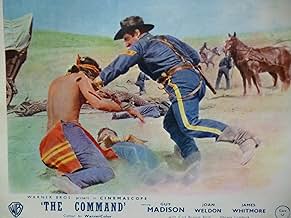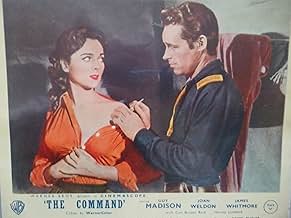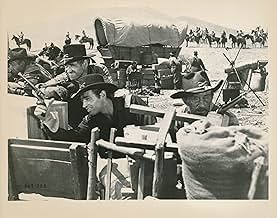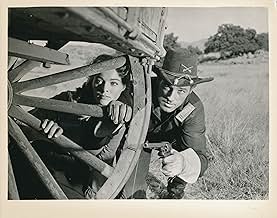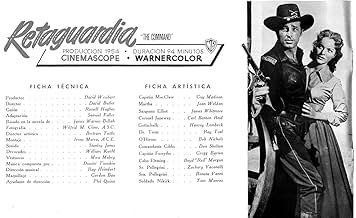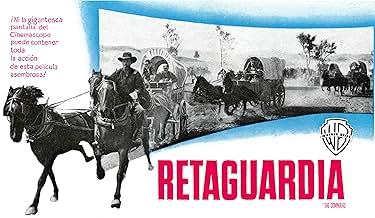IMDb RATING
6.4/10
706
YOUR RATING
An Army doctor with no combat experience is forced to take command of a cavalry troop escorting a wagon train through hostile Indian country when the unit's commanding officer dies.An Army doctor with no combat experience is forced to take command of a cavalry troop escorting a wagon train through hostile Indian country when the unit's commanding officer dies.An Army doctor with no combat experience is forced to take command of a cavalry troop escorting a wagon train through hostile Indian country when the unit's commanding officer dies.
- Director
- Writers
- Stars
Robert Nichols
- 2nd Lt. O'Hirons
- (as Bob Nichols)
Carl Andre
- Trooper
- (uncredited)
Emile Avery
- Outrider
- (uncredited)
Jim Bannon
- Infantryman
- (uncredited)
Gregg Barton
- Capt. Forsythe
- (uncredited)
George Bell
- Webb
- (uncredited)
John Beradino
- Sergeant Major
- (uncredited)
Richard Boyer
- Infantry Sergeant
- (uncredited)
Larry Chance
- Indian Brave
- (uncredited)
Mack Chandler
- Infantry Lieutenant
- (uncredited)
- Director
- Writers
- All cast & crew
- Production, box office & more at IMDbPro
Featured reviews
This is a very good story that was made into a very compelling western by director David Butler from James Warner Bellah's novel "rear guard". Samule Fuller and Russell S. Hughes get credit for the tau and only occasionally glossy screenplay. Star Guy Madion made several estimable and well-remembered westerns in the 1950s, in which decade he also starred in the "Wild Bill Hickick" TV series along with Andy Devine. The intriguing part of this standard story-line which concerns a ranking officer having to assume leadership of a cavalry outfit after the death of its senior officer is that this man happens to be a medical Captain, not a field commander. They fall in with a wagon train during Indian troubles, and end up meeting infantry as well, whom his second, powerfully played by James Whitmore, refers to as "stinkin' beetle crushers". Madson assumes command of both groups, romances lovely and talented Joan Weldon, and nurses the wagon train through sickness and danger; then, at the last, he gets the inspiration to mount cannon onto the wagons, form a hollow square, and draw the Indians into an ambush. Thus, he uses his imagination to defeat the Indian's long-delayed final attack. Madison gets Weldon, Whitmore's honor as a cavalrymen is served, and all ends well; but there are good dialogue confrontations and strong situations along the way, plenty of battle action and unusually strong character revelations. Music was supplied for this film by veteran Dimitri Tiomkin, costumes by Moss Mabry. The fine cinematography was the work of Wilfrid M. Cline. In the professional cast along with Madison, Whitmore and Weldon were Carl Benton Reid, Harvey Lembeck, Ray Teal, Robert Nichols, Gregg Barton, Renata Vanni, Zacharias Yaconelli, Jim Bannon and others. This is a quality production and a very strong story line which has to do with being true to values as its general themes. It is exceptionally well- carried-out, I suggest and thoughtful, not just for a western but for any genre of film.
10segstef
The good thing about this movie is the sympathy toward Native Americans. The Native Americans had no immunity to smallpox or chicken pox and no medicine to treat diseases. The main character played by Guy Madison constantly showed concern toward the Native Americans although he had to fight them. Although this movie had this social issue,it still had all the rousing entertainment of most calvary movies. The movie had a lot of saluting, which sometimes became a distraction. James Whitmore was great as the seasoned veteran just as he was in "Battleground". This movie had me wanting both sides to win.
After Captain Gregg Barton has been killed before dying he placed his troop of cavalry in the hands of the only officer left, army doctor Guy Madison. Madison is bringing them back to their fort when they meet up with a company of infantry and the wagon train they're escorting through Indian country. The short tempered Colonel Don Shelton, commandeers that same cavalry to help with the escort without knowing that Madison has no military training. The rest of the cavalrymen keep Madison's real army specialty a secret lest they spread some panic among the settlers.
Of course The Command that Madison is stuck with is no milk run. He's got to learn some real military tactics and has to learn them fast. Among the settlers there is an outbreak of what could be smallpox and Madison is hamstrung in giving aid in the profession he is trained in. Out of necessity he has to tell Joan Weldon who is traveling with the wagon train in the wagon where the sickness is starting.
The Command was one of the first film's done in the wide screen process with some 3D thrown in for good measure. With films on the big screen competing with the free small screen, gimmicks were thought to be needed to get the public out of their living rooms. A good solid cavalry western which The Command is was not enough at times.
James Whitmore as the sergeant who by rights should have been in charge and wisecracking Harvey Lembeck stand out in this cast. With a doctor hero and a cavalry setting, I'm surprised John Ford wasn't brought in for The Command. It seems like just his kind of material.
Of course The Command that Madison is stuck with is no milk run. He's got to learn some real military tactics and has to learn them fast. Among the settlers there is an outbreak of what could be smallpox and Madison is hamstrung in giving aid in the profession he is trained in. Out of necessity he has to tell Joan Weldon who is traveling with the wagon train in the wagon where the sickness is starting.
The Command was one of the first film's done in the wide screen process with some 3D thrown in for good measure. With films on the big screen competing with the free small screen, gimmicks were thought to be needed to get the public out of their living rooms. A good solid cavalry western which The Command is was not enough at times.
James Whitmore as the sergeant who by rights should have been in charge and wisecracking Harvey Lembeck stand out in this cast. With a doctor hero and a cavalry setting, I'm surprised John Ford wasn't brought in for The Command. It seems like just his kind of material.
A great Western that entertains well. It is a movie, along with "Charge at Feather River", where Guy Madison plays a character that though having to fight the Indians, also understands their situation.
The chemistry between Madison's and Whitmore's characters was very well played. It is well paced with story moments and action moments fitting together well.
As a historical note, the Winchesters used by the troopers were incorrect as props but then this was a 1950s Western when no one cared about those details. Spencer Carbines would have been correct but unavailable. The one interesting gun prop is in the scene where the scouts are chased back to the column and meet up with the Capt. and others. One of the troopers is obviously holding a Schofield revolver which though quite unusual, were used by the U.S. Cavalry in small numbers.
I really hope that this movie is released on DVD someday soon.
The chemistry between Madison's and Whitmore's characters was very well played. It is well paced with story moments and action moments fitting together well.
As a historical note, the Winchesters used by the troopers were incorrect as props but then this was a 1950s Western when no one cared about those details. Spencer Carbines would have been correct but unavailable. The one interesting gun prop is in the scene where the scouts are chased back to the column and meet up with the Capt. and others. One of the troopers is obviously holding a Schofield revolver which though quite unusual, were used by the U.S. Cavalry in small numbers.
I really hope that this movie is released on DVD someday soon.
This is one of those old Cowboy versus Indian westerns. As a kid growing up the cowboys were the good guys and the Indians the bad guys. Obviously as you grow up you realise that this wasn't the case. As a result the sight of Native Americans being mown down, leaves me slightly peeved. However I did watch the film in the context of the time it was made.
Although it does drag in parts towards the middle, in the main this is a very well made western with some great action scenes as the cavalry do battle with the Indians. The final battle scenes were excellently done. Guy Madison does a good job as the charismatic doctor finding himself in charge of a troop when the commanding officer is killed. There is a bit of humour thrown in now and again and of course the the obligatory romance with the love interest being played by the beautiful Joan Weldon.
Although not a truly great Western it's certainly an above average one and well worth watching for fans of this genre.
Although it does drag in parts towards the middle, in the main this is a very well made western with some great action scenes as the cavalry do battle with the Indians. The final battle scenes were excellently done. Guy Madison does a good job as the charismatic doctor finding himself in charge of a troop when the commanding officer is killed. There is a bit of humour thrown in now and again and of course the the obligatory romance with the love interest being played by the beautiful Joan Weldon.
Although not a truly great Western it's certainly an above average one and well worth watching for fans of this genre.
Did you know
- TriviaAt about 79 minutes, in a scene of Indians attacking the wagons full of soldiers, one Indian gets shot off his horse, then is run over by a wagon drawn by four horses . That wasn't a planned stunt--he was supposed to be "shot" and fall off the side of his horse, but the horse unexpectedly reared back and dumped him into the path of the wagon, which ran over him. He suffered numerous broken bones and ribs, but the scene was left in.
- GoofsIn 1876 the single-shot Springfield Model 45-70 1873 rifle was the standard US Army infantry rifle, as identified by Captain MacClaw when he picks up an abandoned one. The cavalry used a single-shot carbine version of the Springfield 1873. Yet the final battle sequences show both the infantry and the cavalry troopers exclusively using Winchester or Henry style lever action repeating rifles, even though these weapons were never Army issue.
- Quotes
Sgt. Elliott: Never say an Injun is dumb. He just waits for the chance to use his one good cavalry tactic: ring around and close in.
- ConnectionsReferenced in Mademoiselle Porte-bonheur (1954)
- How long is The Command?Powered by Alexa
Details
Box office
- Gross US & Canada
- $2,500,000
- Runtime
- 1h 34m(94 min)
Contribute to this page
Suggest an edit or add missing content

